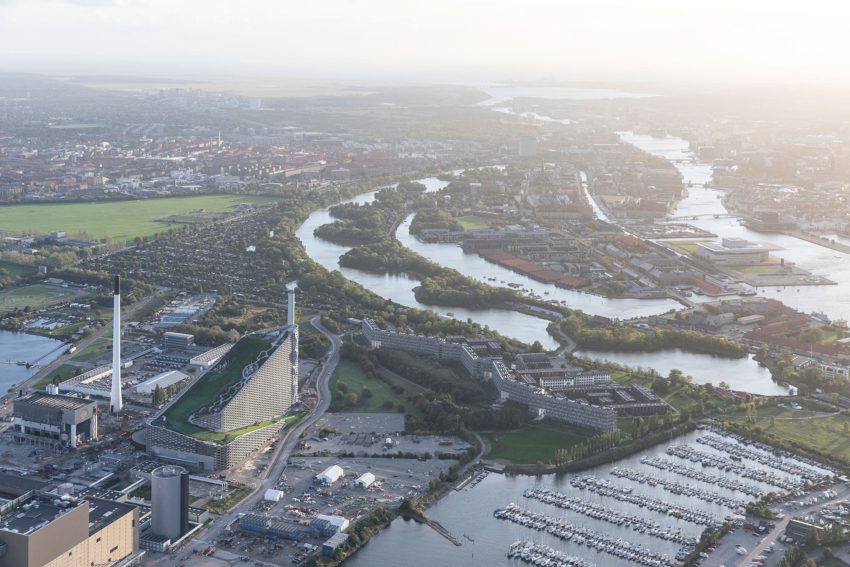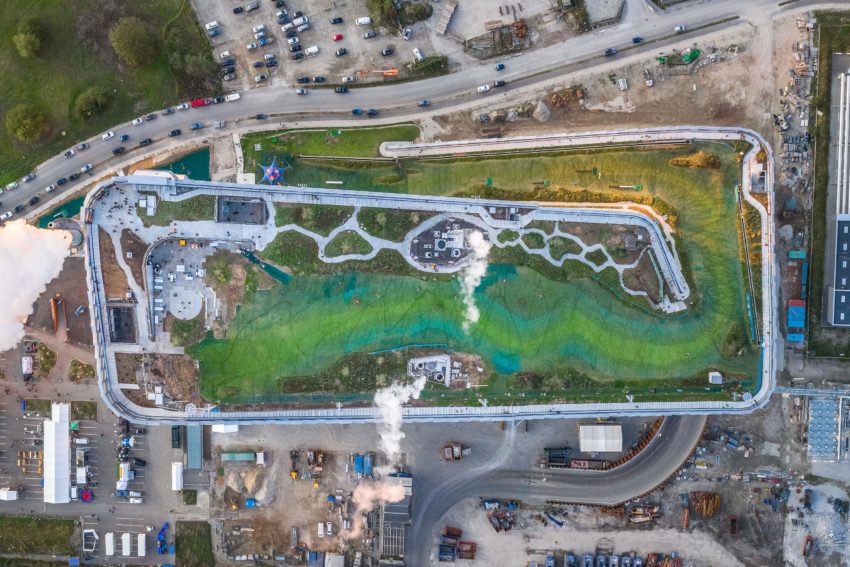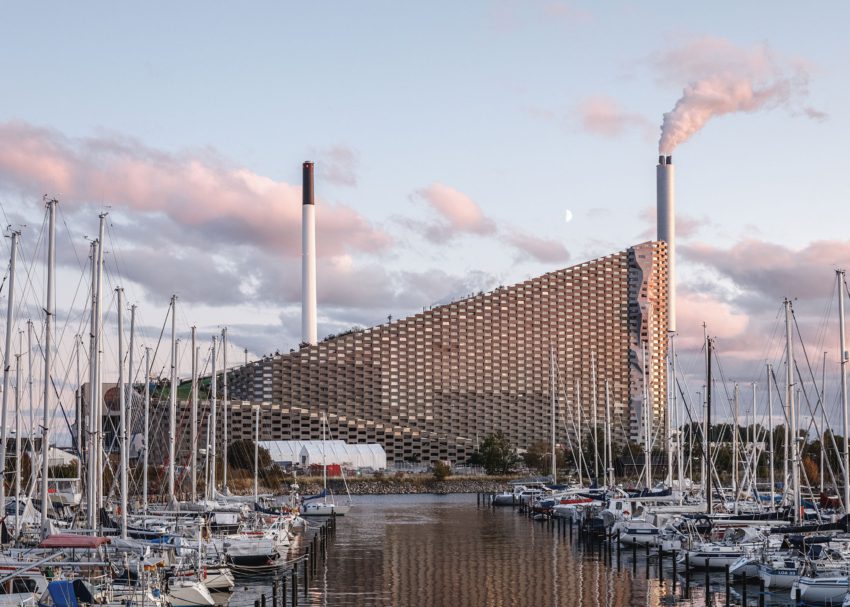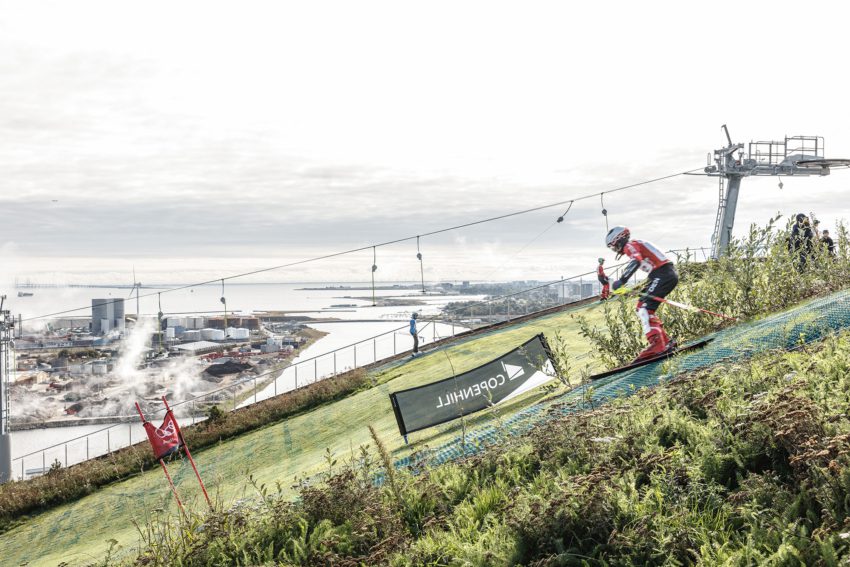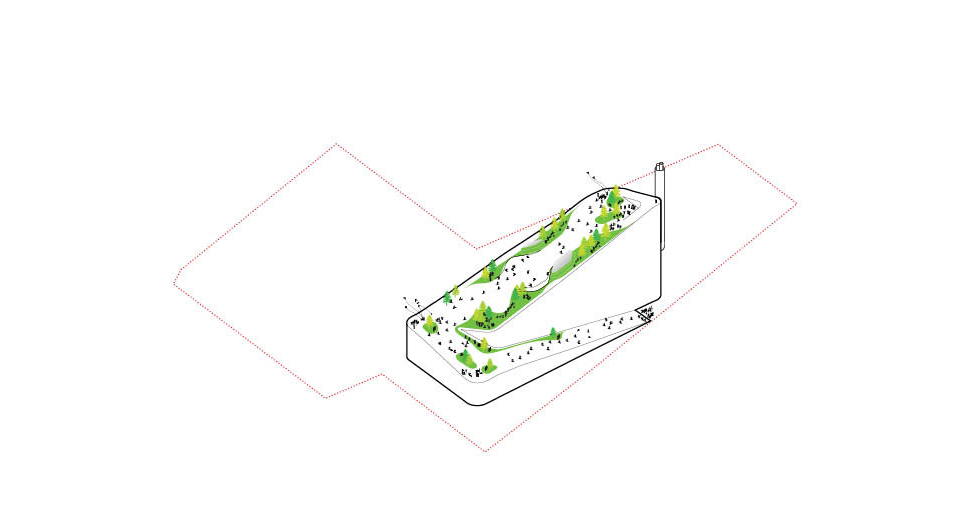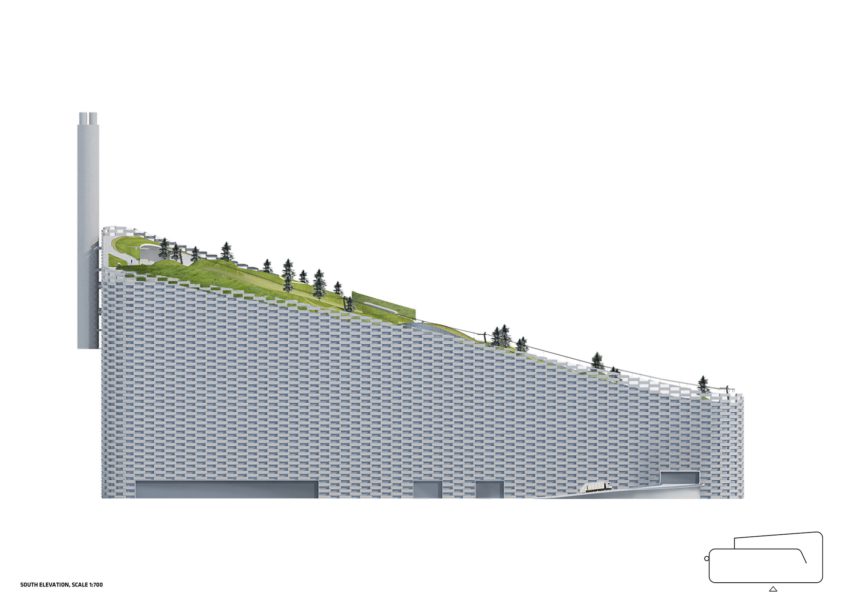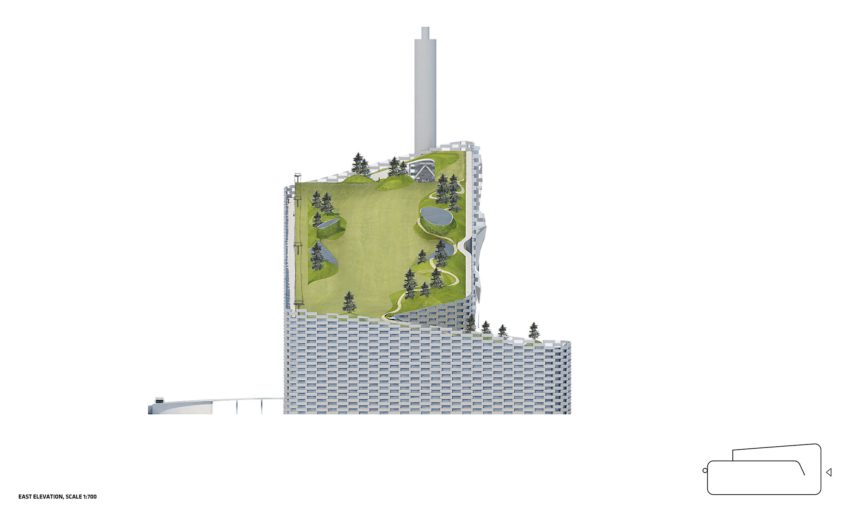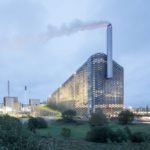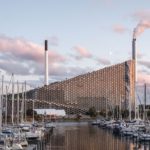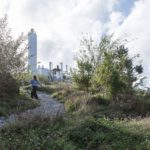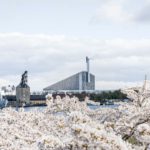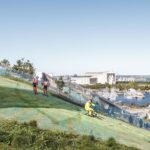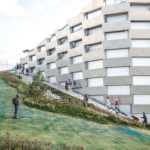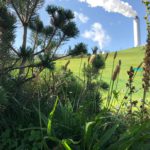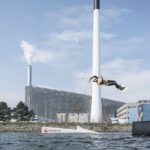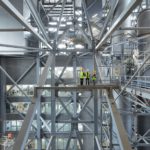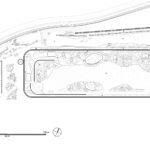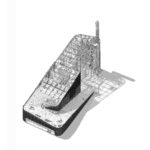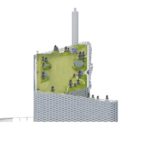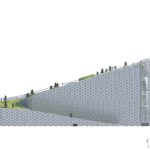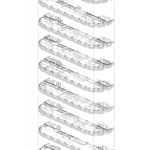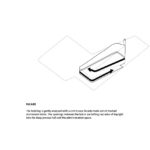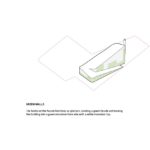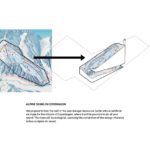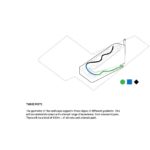Completed in 2017 by Bjarke Ingels Group, CopenHill is a groundbreaking project that redefines what a waste-to-energy plant can be. This 41,000m2 facility not only efficiently converts waste into energy but also features an urban recreation center and environmental education hub for the community. CopenHill has quickly become an architectural landmark, embodying the notion of sustainability and aligning with Copenhagen’s ambitious goal of becoming the world’s first carbon-neutral city by 2025.
With its innovative design, CopenHill challenges the perception of waste management facilities and transforms them into positive contributions to the environment and the community. The plant’s striking facade features an 85-meter-tall ski slope, which has become a popular destination for skiing and snowboarding enthusiasts year-round. The rooftop also features a running trail, and the center offers a variety of activities, such as climbing, hiking, and kayaking.
CopenHill Power Plant Technical Information
- Architects: Bjarke Ingels Group
- Design Team1&2: Bjarke Ingels, David Zahle, Jakob Lange, Brian Yang
- Landscape Architects: SLA
- Location: Amager, Copenhagen, Denmark
- Topics: Power Plant, Sports Facility
- Area: 41000 m2
- Project Year: 2017
- Photographs: © Laurian Ghinitoiu, © Rasmus Hjortshoj, © SLA, © Soren-Aagaard
CopenHill is conceived as a public infrastructure with intended social side-effects from day one. Replacing the adjacent 50-year old waste-to-energy plant with Amager Ressourcecenter, CopenHill’s new waste incinerating facilities integrate the latest technologies in waste treatment and energy production.
– BIG Architects
CopenHill Waste-to-Energy Plant Photographs
CopenHill: A New Breed of Waste-to-Energy Plant and Recreational Center
Text by the Architects
CopenHill, also known as Amager Bakke, opens as a new breed of waste-to-energy plant topped with a ski slope, hiking trail, and climbing wall, embodying the notion of hedonistic sustainability while aligning with Copenhagen’s goal of becoming the world’s first carbon-neutral city by 2025. CopenHill is a 41,000m2 waste-to-energy plant with an urban recreation center and environmental education hub, turning social infrastructure into an architectural landmark.
CopenHill is conceived as a public infrastructure with intended social side effects from day one. Replacing the adjacent 50-year-old waste-to-energy plant with Amager Ressourcecenter (ARC), CopenHill’s new waste incinerating facilities integrate the latest waste treatment and energy technologies production. Due to its location on the industrial waterfront of Amager, where raw industrial facilities have become the site for extreme sports, from wakeboarding to go-kart racing, the new power plant adds skiing, hiking, and rock climbing to thrill-seekers’ wish lists.
The power plant’s internal volumes are determined by the precise positioning and organization of its machinery in height order, creating an efficient, sloping rooftop fit for a 9,000m2 ski terrain. At the top, experts can glide down the artificial ski slope with the same length as an Olympic half-pipe, test the freestyle park or try the timed slalom course while beginners and kids practice on the lower slopes. Skiers ascend the park from the platter lift, carpet lifts, or glass elevator for a glimpse inside the 24-hour operations of a waste incinerator.
Recreation buffs and visitors reaching the summit of CopenHill will feel the novelty of a mountain in an otherwise-flat country. Non-skiers can enjoy the rooftop bar, cross-fit area, climbing wall, or highest viewing plateau in the city before descending the 490m tree-lined hiking and running trail within a lush, mountainous terrain designed by Danish Landscape Architects SLA. Meanwhile, the 10,000m2 green roof addresses the challenging micro-climate of an 85m high park, rewilding a biodiverse landscape while absorbing heat, removing air particulates, and minimizing stormwater runoff.
Beneath the slopes, whirring furnaces, steam, and turbines convert 440,000 tons of waste annually into enough clean energy to deliver electricity and district heating for 150,000 homes. The necessities of the power plant to complete this task, from ventilation shafts to air-intakes, help create the varied topography of a mountain, a human-made landscape created in the encounter between the needs from below and the desires from above. Ten floors of administrative space are occupied by the ARC team, including a 600m2 education center for academic tours, workshops, and sustainability conferences.
Rather than consider ARC as an isolated architectural object, the building envelope is conceived as an opportunity for the local context while forming a destination and a reflection on the progressive vision of the company.
CopenHill’s continuous façade comprises 1.2m tall and 3.3m wide aluminum bricks stacked like gigantic bricks overlapping with each other. In-between, glazed windows allow daylight to reach deep inside the facility, while larger openings on the southwest façade illuminate workstations on the administrative floors.
On the longest vertical façade, an 85m climbing wall is installed to be the tallest artificial climbing wall in the world for new world records to be broken with views inside the factory. At the bottom of the ski slope, a 600m2 après-ski bar welcomes locals and visitors to wind down once the boots are off. Formerly a piece of infrastructure in an industrial zone, CopenHill becomes the new destination for families, friends, and celebration, one that is economically, environmentally, and socially profitable.
CopenHill Waste-to-Energy Plant Plans
CopenHill Waste-to-Energy Plant Image Gallery
- © Laurian Ghinitoiu
- © Laurian Ghinitoiu
- © Rasmus Hjortshoj
- © Rasmus Hjortshoj
- © Rasmus Hjortshoj
- © Laurian Ghinitoiu
- © Aldo Amoretti
- © Rasmus Hjortshoj
- © Rasmus Hjortshoj
- © Rasmus Hjortshoj
- © Rasmus Hjortshoj
- © SLA
- © Aldo Amoretti
- © Soren Aagaard
- © Soren Aagaard
- © BIG- Bjarke Ingels Group
- © SLA
- © BIG – Bjarke Ingels Group
- © BIG- Bjarke Ingels Group
- © BIG- Bjarke Ingels Group
- © BIG- Bjarke Ingels Group
- © BIG – Bjarke Ingels Group
- © BIG- Bjarke Ingels Group
- © BIG- Bjarke Ingels Group
- © BIG- Bjarke Ingels Group
- © BIG- Bjarke Ingels Group
- © BIG- Bjarke Ingels Group
- © BIG- Bjarke Ingels Group
- © BIG- Bjarke Ingels Group
- © BIG- Bjarke Ingels Group
- © BIG- Bjarke Ingels Group
- © BIG- Bjarke Ingels Group
About Bjarke Ingels Groups
Bjarke Bundgaard Ingels is a Danish architect, founder, and creative partner of Bjarke Ingels Group (BIG). The studio has worked on numerous projects worldwide, all sharing a visionary view and an interest in innovative theories about contemporary society and lifestyles. Its two offices in Copenhagen and New York bring together professionals from all over the world, promoting cultural exchange as a source of wealth in design.
Other works from BIG
- Project Leaders: Jesper Boye Andersen, Claus Hermansen, Nanna Gyldholm Møller
- Team: Alberto Cumerlato, Aleksander Wadas, Alexander Codda, Alexander Ejsing, Alexandra Gustafsson, Alina Tamosiunaite, Armor Gutierrez, Anders Hjortnæs, Andreas Klok Pedersen, Annette Jensen, Ariel Wallner, Ask Andersen, Balaj IIulian, Blake Smith, Borko Nikolic, Brygida Zawadzka, Buster Christensen, Chris Falla, Chris Zhongtian Yuan, Daniel Selensky, Dennis Rasmussen, Espen Vik, Finn Nørkjær, Franck Fdida, Gonzalo Castro, Gül Ertekin, George Abraham, Helen Chen, Henrick Poulsen, Henrik Rømer Kania, Horia Spirescu, Jakob Ohm Laursen, Jean Strandholt, Jelena Vucic, Jeppe Ecklon, Ji-young Yoon, Jing Xu, Joanna Jakubowska, Johanna Nenander, Kamilla Heskje, Katarzyna Siedlecka, Krzysztof Marciszewski, Laura Wätte, Liang Wang, Lise Jessen, Long Zuo, Maciej Zawadzki, Mads Enggaard Stidsen, Marcelina Kolasinska, Marcos Bano, Maren Allen, Mathias Bank, Matti Nørgaard, Michael Andersen, Narisara Ladawal Schröder, Niklas A. Rasch, Nynne Madsen, Øssur Nolsø, Pero Vukovic, Richard Howis, Ryohei Koike, Se Hyeon Kim, Simon Masson, Sunming Lee, Toni Mateu, Xing Xiong, Zoltan David Kalaszi, Tore Banke, Yehezkiel Wiliardy


